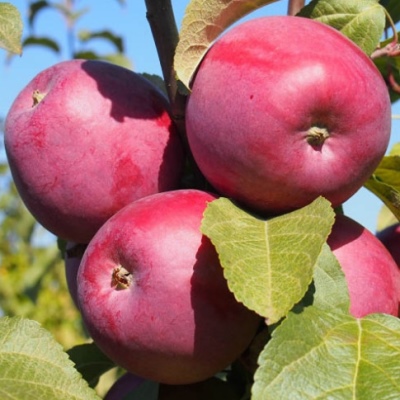
- Authors: Belarusian selection (BelNIIP)
- Taste: sweet, with berry flavor
- Fruit weight, g: up to 180
- Fruit size: large
- Yield: high
- Frequency of fruiting: regular
- The beginning of fruiting varieties: for 3 years
- Ripening terms: winter
- Removable maturity: late September - early October
- Keeping quality: up to 150 days
Among the Belarusian varieties of apple trees, gardeners especially distinguish Zorka. In recent years, this type of fruit crop has been gaining more and more popularity, due to its unpretentious care and high resistance to diseases and pests.
Breeding history of the variety
Zorka belongs to the varieties of the Belarusian selection. This variety was created at BelNIIP in 1987. The variety was obtained by crossing two types of apple trees: Liberty and Antey. The synonymous name of the culture is Zorka.
Description of the variety
Dawn is a medium-sized variety. The tree is of medium height - about 4 meters. The crown is wide, oval in shape. The thickening is average. As the tree matures, the crown becomes spherical. The main branches have a brown bark, grow upward and to the sides. Shoots are also brown, often curved. They are faceted in cross-section.
The foliage is distinguished by a bright green juicy color and an oblong-ovoid shape. Oval specimens are sometimes found. Notches are noted along the edges, there is a slight wrinkling. When the tree begins to bloom, it is strewn with large white flowers with a pinkish tint. They resemble a saucer in shape.
Features, pros and cons
A feature of Zorka is the early onset of fruiting. This happens already at 3 years old, while most varieties of apple trees begin to bear fruit only at 4-5 years. There are other positive characteristics:
excellent winter hardiness;
resistance to dry weather;
high immunity to most diseases of a fungal nature;
rapid maturation.
This variety also has a drawback - if it is grafted onto another tree, you can not expect quick fruiting. It will come only on the 7th year. Additional disadvantages: apples of different sizes in the same harvest, as well as a weak color of fruits growing in the shade.
Ripening and fruiting
Zorka is a winter variety of apple trees. At the end of September or the beginning of October, the removable ripeness of the fruit starts. The duration of the consumer period is 4 months: it starts in November and ends in February. The apple tree bears fruit annually starting at the age of 3 years.
Yield
Dawn is considered a high-yielding variety. With proper care, 90 kilograms of fruit can be harvested from one tree. Gardeners get up to 33 tons of apples per hectare.
Fruits and their taste
The fruits from the Zorka tree are mainly consumed fresh. The apple is green in color, covered with a bright pink blush. The shape resembles a ball, the fruits are slightly elongated at the top. The weight is quite solid - up to 180 grams. The fruits are large.
Inside the apple is a juicy greenish pulp. The taste is sweet, berry shade is felt. The shelf life of the fruit is 150 days. The taste was rated 4.7 points.

Growing features
For planting, seedlings are chosen that are 2 years old.It is best to plant sprouts in the spring, when it gets warmer, but you can also in the fall, at least a month before frost. It is important to prepare the soil in six months by mixing it with humus and compost. When planting, be sure to use a peg to support the seedling.
The soil for growing Zorka should be slightly acidic, acidity - 5.1-7 pH. The place should be chosen sunny, windproof. Right at the time of planting, the central trunk is cut into 2-3 buds.
As for watering, they should be regular. The first year of life should be watered once every 14 days, subsequently - once every 21 days. Each time the apple tree will need 2 buckets of water, 10 liters each. After watering, the land will need to be loosened a little.
When the tree reaches the age of 2 years, molding pruning is performed on it. The same should be done for 3 years. After that, only sanitary procedures will be needed.



Pollination
The cultivar does not pollinate on its own and needs companions. These should be trees of the winter ripening period, the flowering time of which coincides with the flowering of the Dawn. Such trees should be located close to the described variety.
Top dressing
You need to feed the seedling for the first time for 3 years. In mid-March, he is given fertilizer with a large amount of nitrogen. Before flowering, the plant will need potassium, boron and a large amount of phosphorus. After flowering, it is important to give a complex top dressing, in which there will be a minimum of nitrogen. Potash fertilizers are used in autumn. Wood ash is a very good option.

Frost resistance
The apple tree Dawn is able to withstand frosts down to -35 degrees, which means that it is very frost-hardy. But in the early years, while the plant is still young, it must be covered. Spruce branches or dry peat are placed in the trunk circle. It is important to whitewash the barrel. The crown is wrapped with agrofiber or spunbond.


The apple tree is a popular fruit crop among gardeners. It can be found in many summer cottages. But at the same time, such trees are often affected by various diseases. It is very important to recognize the disease in time and carry out the necessary procedures for a speedy recovery.Otherwise, the fruits will be spoiled, and the tree itself may die altogether.












































































